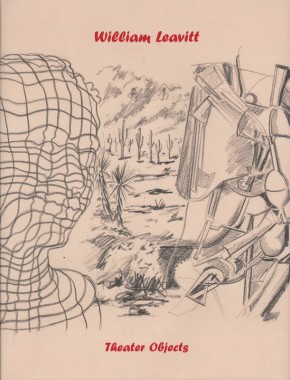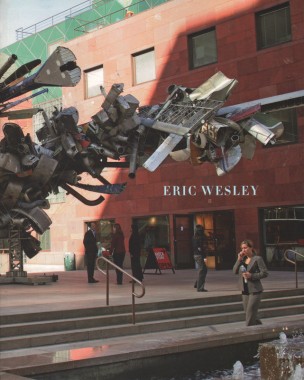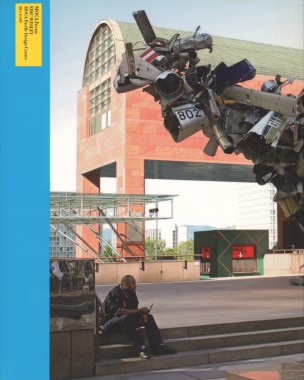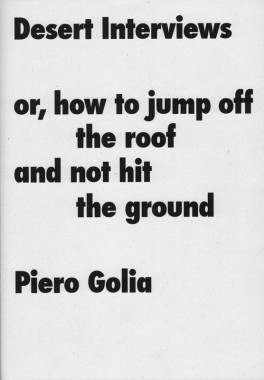
William Leavitt, Theater Objects
Softcover, 148 pp., offset 4/4, 230 x 300 mm
Edition of 5000
ISBN 978-1-933751-18-4
Published by MOCA
$40.00 · out of stock
A pioneer of Conceptual art in Los Angeles during the late 1960s and 1970s, the painter, installation artist and theater director William Leavitt (born 1941) is above all an artist of narrative devices. Since 1969, his works in all the above media have employed abrupt fragments of popular and vernacular culture and depictions of modernist architecture to construct elusive narratives of cityscapes and environments. The culture and atmosphere of Los Angeles has played a significant role in Leavitt’s handling of these themes; classic southern Californian motifs of ever-present artifice and almost washed-out brightness recur throughout his work. Surveying the artist’s 40-year career, this volume includes sculptural tableaux, paintings, works on paper, photographs and performances from the late 1960s to the present. Leavitt has created a remarkable oeuvre that has influenced generations of artists, and this volume is both long overdue and highly anticipated.
Ann Goldstein, Annette Leddy, Art, Bennett Simpson, DAP, Elizabeth Hamilton, Erik Bluhm, Lisa Mark, Michael Worthington, William Leavitt


Eric Wesley, Eric Wesley
Softcover, 60 pp., offset 4/4, 8 x 10 inches
Edition of 2000
ISBN 978-0-914357-97-1
Published by MOCA
$25.00 · out of stock
West Coast artist Eric Wesley was born in 1973 in Los Angeles. His work, which can take the form of sculpture, painting, drawing, architectural model or public artwork proposal, often uses decrepit materials and conveys a humorous take on the world and his own identity within it. For the Whitney Biennial, he created scale sets for a faux reality show; his kinetic sculpture Kicking Ass was a mechanized donkey that kicked holes in the gallery wall behind it. This small monograph is the first publication dedicated solely to the artist’s work, and is published on the occasion of his exhibition as part of the MOCA Focus series.
Art, Cornelia Butler, DAP, Elizabeth Hamilton, Eric Wesley, Jane Hyun, Lisa Mark, Michael Worthington, MOCA, Sculpture, Yasmin Khan

Piero Golia, Desert Interviews or, how to jump off the roof and not hit the ground
Softcover, 100 pp., offset 4/1, 148 x 210 mm
Edition of 2000
ISBN 978-3-03764-106-4
Published by JRP|Ringier
$28.00 ·
Piero Golia founded in 2005, with his long-time friend Eric Wesley, the Mountain School of Arts, an educational structure that rapidly became a new spot on the cultural map of the city of Los Angeles.
This book, composed of discussions between artists, presents a kind of report on this unique “institution:” teaching methods, academic syllabus, and students’ selection are here explained with metaphors, compared with artistic interaction, and equaled to performances. Not unlike Golia’s work itself, the development of the school and its program follow a poetic of the gesture, of the instant, and of actions recalling Fluxus, Gino de Dominicis’ or Paul McCarthy’s works.
As a career’s start, Piero Golia successfully convinced a woman to have his portrait and the words “Piero My Idol” tattooed on her back (tattoo, 2001); soon after, following an invitation to the Tirana Biennale, he rowed across the Adriatic Sea in the opposite direction to migratory movement to reach Albania (”Going to Tirana,” 2000). And, on January 14, 2005, Golia vanished from New York City leaving no documented proof of his whereabouts; he traveled from a place to another, crossing borders without a trace, for resurfacing only on the morning of February 7 at the Royal Academy of Arts in Copenhagen for a unique lecture about his adventurous trip. He now lives in Los Angeles, a place that blurs the boundaries between reality and fiction, making it the perfect setting for his exploration into the process of myth-making and his ironic outlook on contemporary society.
Andrew Berardini, Art, DAP, Education, Emilie Renard, Eric Wesley, Fluxus, Gino de Dominicis, John Armleder, JRP|Ringier, Lisa Mark, Los Angeles, Mountain School of Arts, Paul McCarthy, Piero Golia, Pierre Huyghe, Richard Jackson, Royal Academy of Arts in Copenhagen, Tirana Biennale



